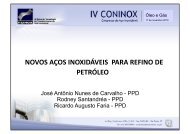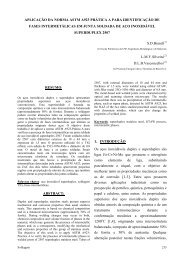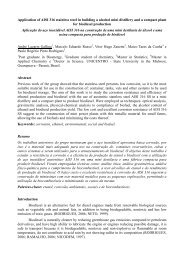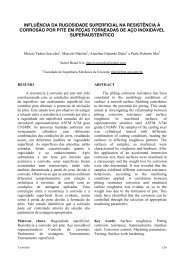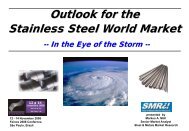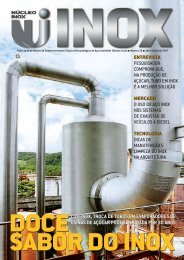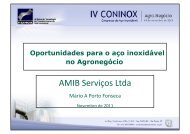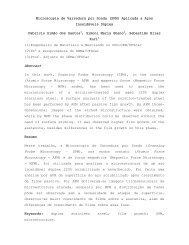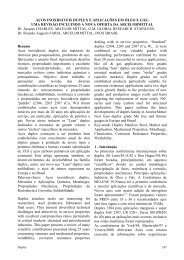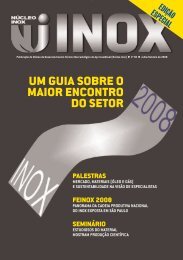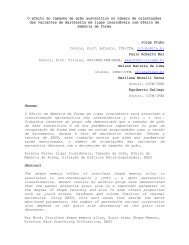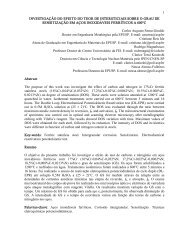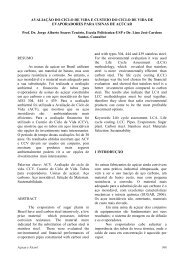Orbital Welding of Duplex Stainless Steel Tubing and
Orbital Welding of Duplex Stainless Steel Tubing and
Orbital Welding of Duplex Stainless Steel Tubing and
Create successful ePaper yourself
Turn your PDF publications into a flip-book with our unique Google optimized e-Paper software.
The PQR reflects the distribution <strong>of</strong> weld sizes <strong>and</strong> joint configurations for fully orbital welds or<br />
manual root passes combined with orbital welding. Pipe-to-elbow or tee fitting welds were done with a<br />
manual root followed by orbital filler passes, while pipe-to-pipe welds with a J end preparation (Figure<br />
4.) were completely orbitally welded. In the pipeshop the pipe was segregated by ODs larger <strong>and</strong><br />
smaller than 4 inches. (Figure 4.)<br />
.<br />
Figure 3. Left: Detail from BrasFELS’ PQR showing separation <strong>of</strong> duplex stainless steel pipe by sizes<br />
over 4 inches <strong>and</strong> 4 inches <strong>and</strong> less. It also shows manual root passes for pipe-to-fitting welds <strong>and</strong><br />
complete orbital welds for pipe-to-pipe joints. Right: A modified “J” end preparation is recommended<br />
for orbital welding <strong>of</strong> pipe.<br />
Arc Machines employee, Eng. Angel Brond, worked closely with BrasFELS to develop their PQR<br />
according to the requirements for limiting the heat input in duplex stainless steel welds listed in<br />
Offshore St<strong>and</strong>ard DNV-OS-F101, Submarine Pipeline Systems, October 2007, App. C. This<br />
st<strong>and</strong>ard requires the control <strong>of</strong> heat input to avoid detrimental weld cooling rates. In order to<br />
achieve optimum control <strong>of</strong> heat input they recommend faster welding times <strong>and</strong> higher welding<br />
currents. Stringer beads are recommended to ensure a constant heat input <strong>and</strong> any weaving <strong>of</strong> the<br />
weld bead was limited to a maximum <strong>of</strong> 3 times the filler wire or electrode diameter. In this case the<br />
wire diameter was 0.035 inches supplied by S<strong>and</strong>vik. The heat input for girth welds was limited to a<br />
range <strong>of</strong> 0.5 – 1.8 kJ/mm, with the lower end <strong>of</strong> the range specified for thinner wall pipe. It was also<br />
required that welding be continuous for an entire pass rather than stopping <strong>and</strong> starting the arc or<br />
performing a split pass.<br />
Appendix C <strong>of</strong> DNV-OS-F101 required that welding personnel be qualified to ISO 14732 <strong>and</strong> EN<br />
1418. Qualification <strong>of</strong> welding operators was done by BrasFELS with AMI consulting on site. As<br />
specified by this st<strong>and</strong>ard, the qualification tests were done on the actual equipment <strong>and</strong> premises<br />
that were used during production welding.<br />
An additional st<strong>and</strong>ard DNV-RP-F112 Recommended Practice - Design <strong>of</strong> <strong>Duplex</strong> <strong>Stainless</strong> <strong>Steel</strong><br />
Subsea Equipment Exposed to Cathodic Protection October 2008 was used as a Recommended<br />
Practice to asses the quality <strong>and</strong> repeatability <strong>of</strong> the ferrite <strong>and</strong> austenite composition <strong>of</strong> the base<br />
metal before welding <strong>and</strong> after welding.<br />
NORSOK M 601 St<strong>and</strong>ard, Edition 5, April 2008 is also referenced with respect to 4.4.4 Heat Input<br />
<strong>and</strong> 5.1 <strong>Welding</strong> Requirements. The maximum variation allowed in heat input is +/- 15%. Table A.3<br />
lists acceptance criteria for welds including the amount <strong>of</strong> weld bead reinforcement or internal<br />
protrusion. A normative annex was added in this edition with color photos for acceptable<br />
oxidations/coloration on the I.D <strong>of</strong> pipes. Color ranges from no color (good) to heavy black, brown<br />
<strong>and</strong> blue discoloration which is unacceptable. Loss <strong>of</strong> corrosion resistance has been shown to be




